
Playlists
 |
Playlist Playlists |
| Le
ouvertures musicali nei film: Musica per i nostri occhi Musical overtures in the movies: Music for our eyes |
|
| Nota: E' disponibile una
versione
pdf di questo Dossier. |
Note: A
pdf version
of this Dossier is available. |
|
|
|
|
Con l'avvento del sonoro, la musica è diventata parte integrante del
linguaggio cinematografico e la colonna sonora ha rapidamente iniziato a
svolgere diverse funzioni: impostare il tono o
l'atmosfera di una storia, evidenziare personaggi o
eventi specifici nella trama e, in generale, aiutare gli spettatori a
partecipare più attivamente allo spettacolo stimolando le proprie
emozioni e sentimenti. Tuttavia, c'è stato un periodo nella storia del cinema, corrispondente alla cosiddetta "età d'oro" di Hollywood (che copre all'incirca gli anni '40 fino all'inizio e alla metà degli anni '60 del secolo scorso) in cui le grandi produzioni, cioè i film che potevano contare su grandi budget, includevano nel film anche un'ouverture musicale, ovvero un brano musicale pensato per essere suonato prima dell'inizio del film vero e proprio. Queste ouverture, che potevano durare diversi minuti, spesso accompagnavano uno schermo vuoto o un'immagine fissa, e per lo più erano concepite per introdurre gradualmente il pubblico al tono o all'atmosfera del film, in modo che, all'inizio del film vero e proprio, gli spettatori fossero già in uno stato d'animo di attesa. In altre parole, un lungo brano musicale preparava gli spettatori al passaggio dalla realtà alla fantasia, dal mondo quotidiano al "mondo dei sogni" del cinema. Tutto questo, ovviamente, poteva essere ottenuto grazie alle particolarità caratteristiche del pubblico. Gli spettatori erano abbastanza pazienti da aspettare l'inizio del film vero e proprio e potevano persino godersi questo "ritardo" nella presentazione come parte della magia generale della visione di un film. A volte queste ouverture venivano suonate con il sipario ancora chiuso e offrivano anche l'opportunità ai ritardatari di entrare nel teatro, trovare i loro posti e prepararsi per lo spettacolo. |
With the advent of sound, music became an integral part of film
language, and the musical score quickly started to fulfil several
functions: setting the tone or mood of a
story, highlighting characters or specific
events in the plot, and, generally speaking, helping viewers to take a
more active part in the show by stimulating their emotions and feelings. However, there was a time in cinema history, corresponding with the so-called Hollywood's "golden age" (roughly covering the '40s to the early and middle '60s of last century) when major productions, i.e. movies which could rely on big budgets, also included as part of the film a musical overture, i.e. a piece of music designed to be played before the actual film began. These overtures, which could last several minutes, often accompanied a blank screen or a fixed image, and were mostly designed to gradually introduce the audience to the tone or atmosphere of the film, so that, when the actual film began, viewers were already in a corresponding expectant mood. In other words, an extended piece of music was thought to prepare viewers for the transition from reality to fantasy, from the everyday world to the "dream" world of the cinema. All this, of course, could be achieved thanks to the particular features of the audiences. People were patient enough to wait for the real film to start, and could even enjoy this "delay" in presentation as part of the overall magic of watching a movie. Sometimes these overtures were played with the curtains still closed, and also offered an opportunity for late-comers to enter the theatre, find their seats, and arrange themselves in preparation for the show. |
|
Un esempio molto chiaro, e allo stesso tempo estremo, di una sequenza di
apertura composta da un'orchestra al completo che suona un breve brano
sinfonico appare in Come
sposare un milionario,
che inizia con il sipario ancora chiuso, che, aprendosi, rivela
un'orchestra al completo che offre un'ouverture della
durata di più di 7 minuti, composta e diretta da Alfred Newman (il video
completo è disponibile solo su
YouTube). L'ouverture include,
nella sua parte finale, i titoli di testa e una transizione verso una
tipica visione dello skyline di
New York: la musica ricorda vagamente le sinfonie di Gershwin e dà il
giusto tono per una commedia romantica che si svolge principalmente
nella "Grande Mela". |
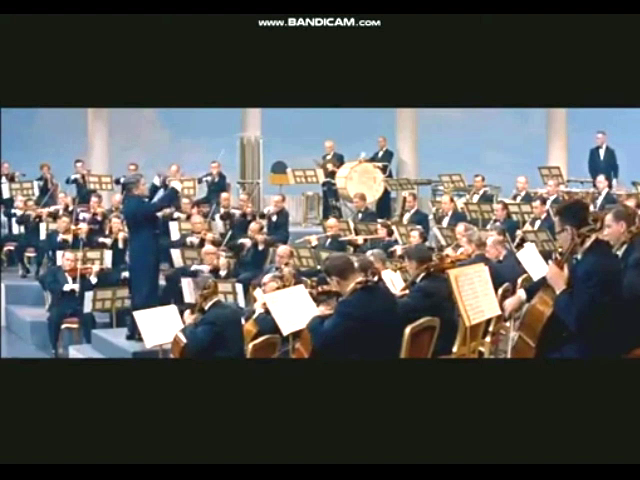 Come sposare un milionario/How to marry a millionaire (di/by Jean Negulesco, USA 1953 |
A very clear, and at the same time extreme, example of an opening sequence consisting of a full orchestra playing a short symphonical piece appears in How to marry a millionaire, which starts with the curtains still drawn, opening to reveal a full orchestra which delivers an overture lasting more than 7 minutes, composed and directed by Alfred Newman (the full video is only available on YouTube). The overture includes, in its final part, the opening credits and a transition to a classical view of the New York skyline - the music is vaguely reminiscent of Gershwin's symphonies and sets the right tone for a romantic comedy that takes place mostly in the "Big Apple". | |
| L'ouverture di apertura includeva spesso i leitmotiv del film, completamente integrati in una partitura che poteva raggiungere un tono sinfonico. È il caso di West Side Story, che si apre su uno schermo da cui pian piano emerge un'immagine di Manhattan. L'ouverture, "anticipando" le melodie dei brani principali del film, riesce anche a introdurre una gamma di toni, che già suggeriscono i vari temi della trama, inclusi sia il romanticismo che il conflitto violento. La colonna sonora è stata composta e diretta da Leonard Bernstein. |
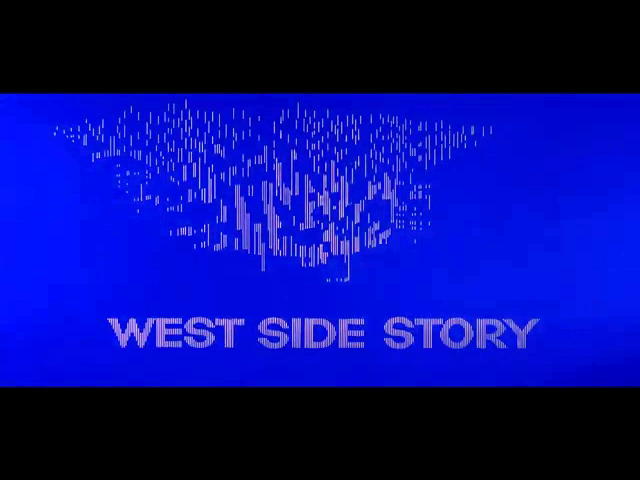 West Side Story (di/by Robert Wise e/and Jerome Robbins, USA 1961) |
The opening overture often included the leitmotifs of the film, fully integrated in a score which could attain a symphonic tone. This is the case of West Side Story, which opens on a screen, from which very slowly emerges an image of Manhattan. By "anticipating" the tunes of the major songs included in the film, the overture also manages to introduce a range of tones, which already suggest the various themes of the plot, including both romance and violent conflict. The musical score was composed and directed by Leonard Bernstein. | |
|
Un'ouverture originalissima
e creativa è la colonna sonora di sottofondo (di Ernest Gold) per i
titoli di testa di Questo
pazzo, pazzo, pazzo, pazzo mondo,
dove la brillante animazione di Saul Bass (si veda il Dossier "Grafica
e design nelle sequenze di apertura di un film")
imposta il tono frenetico e umoristico della trama mentre introduce
accenni ad alcuni dei suoi eventi principali. |
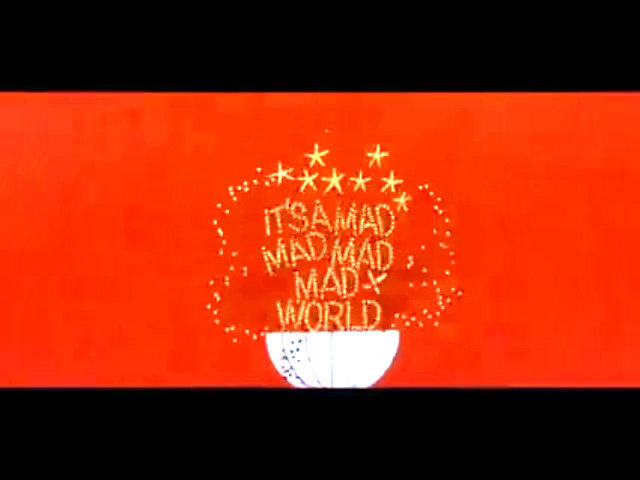 Questo pazzo, pazzo, pazzo, pazzo mondo/It's a mad, mad, mad, mad world (di/by Stanley Kramer, USA 1963) |
A highly original and creative overture is the background musical score
(by Ernest Gold) for the opening credits of It's
a mad, mad, mad, mad world,
where the brilliant animation by Saul Bass (see the Dossier "Graphics
and design in a film's opening sequences") sets the frantic,
humorous tone of the plot while introducing hints to some of its main
events. |
|
| La sequenza iniziale de Il Dottor Zivago, invece, è segnalata fin dall'inizio dal titolo "Ouverture", della durata di oltre quattro minuti, dopodiché iniziano i titoli di testa. Diretto da David Lean, Il dottor Zivago era un dramma romantico epico e storico ambientato in Russia durante la prima guerra mondiale e la guerra civile, e poteva contare su un cast stellare, tra cui Omar Sharif e Julie Christie nei ruoli principali. Vinse cinque Oscar (tra cui proprio quello per la miglior colonna sonora di Maurice Jarre). |
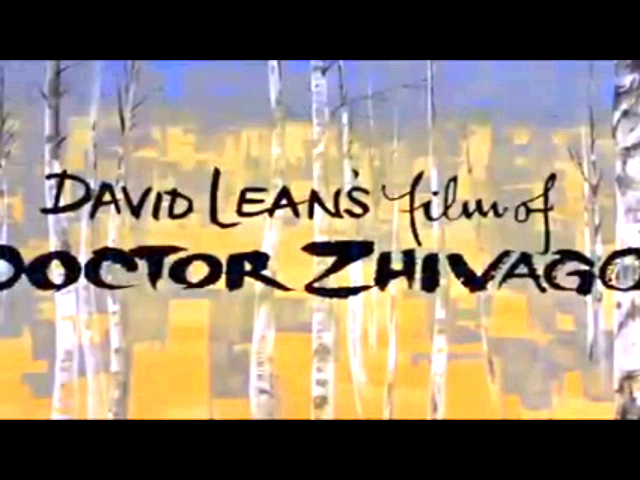 Il dottor Zivago/Doctor Zhivago (di/by David Lean, GB-Italia/Italy 1965) |
The opening sequence of Doctor Zhivago, on the other hand, is signalled right from the start by the title "Ouverture", lasting more than four minutes, after which the opening credits start. Directed by David Lean, Doctor Zhivago was an epic, historical romantic drama set in Russia during World War I and the Civil War, and could rely on an all-star cast, including Omar Sharif and Julie Christie in the leading roles. It won five Oscars (including Best Musical Score by Maurice Jarre). | |
|
Il titolo "Ouverture" segna anche la sequenza di apertura di Sweet
Charity, che, come in West Side Story,
include riferimenti ai principali leitmotiv del
film. Diversi elementi interessanti qualificano questa sequenza: il logo
"Universal Picture" compare durante l'ouverture, che prosegue
con i titoli di testa; il personaggio principale (Shirley MacLaine)
viene mostrato, anche in fermo immagine, prima che un titolo ci informi
che stiamo per vedere "Le avventure di una ragazza che voleva essere
amata". Le immagini che vediamo già ci danno più di un indizio su questo
personaggio, che è attivo e accomodante, generoso e pieno di vita. Il
film è una commedia drammatica musicale che poteva fare affidamento sul
lavoro coreografico di Bob Fosse, qui al suo debutto alla regia di un
lungometraggio. |
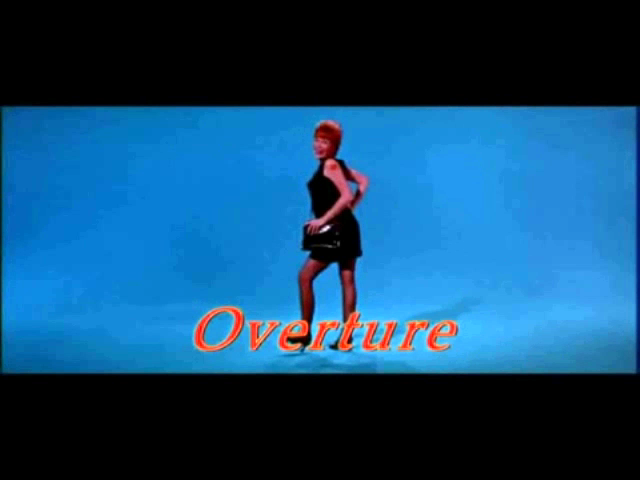 |
The title "Overture" also marks the opening sequence of Sweet Charity, which, as in West Side Story, includes references to the main leitmotifs of the film. Several interesting features qualify this sequence: the "Universal Picture" logo appears during the overture, which goes on with the opening credits; the main character (Shirley MacLaine) is shown, also in freeze-frames, before a title informs us that we are going to watch "The adventures of a girl who wanted to be loved". The images we see already give us more than a hint of this character, who is active and easy-going, generous and full of life. The film is a musical-comedy-drama which could rely on the choreography work of Bob Fosse, here in his feature-film directorial debut. | |
| Oltre a fornire aperture, alcuni dei film di cui ci occupiamo a volte prevedevano anche "intermezzi" o "entr'acte" - una sorta di breve intervallo tra le due parti principali del film, in cui la colonna sonora principale veniva ascoltata mentre, presumibilmente, gli spettatori si alzavano in piedi, andavano al bar, ecc. |
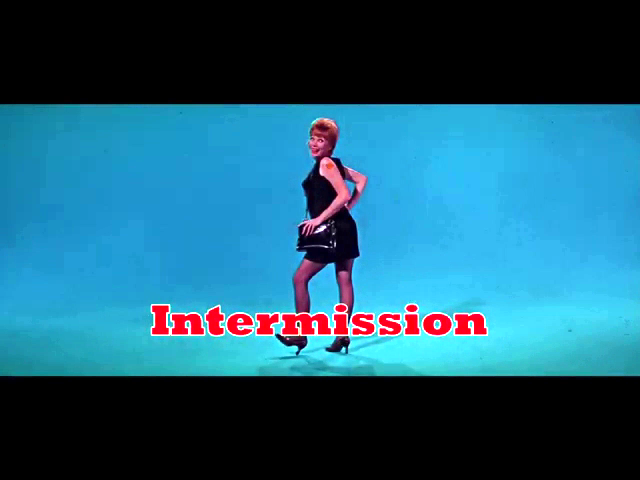 Sweet charity - Una ragazza che voleva essere amata/Sweet charity (di/by Bob Fosse, USA 1969) |
Besides providing overtures, some of the films we are dealing with sometimes also provided "intermissions" or "entr'acte" - a sort of short interval between the two main parts of the film, when the main musical score would be heard while, presumably, people stood up, went to the bar, etc. | |
| Una sequenza di apertura più tradizionale, che incorpora i titoli di testa, sullo sfondo di immagini fisse che rimandano alla storia, è l'ouverture a Funny girl, che, come nella maggior parte dei casi, fornisce anche un riassunto dei principali temi musicali che ricorreranno nel film - tra cui la canzone di fama internazionale "People", cantata da Barbra Streisand (che vinse l'Oscar come migliore attrice). |
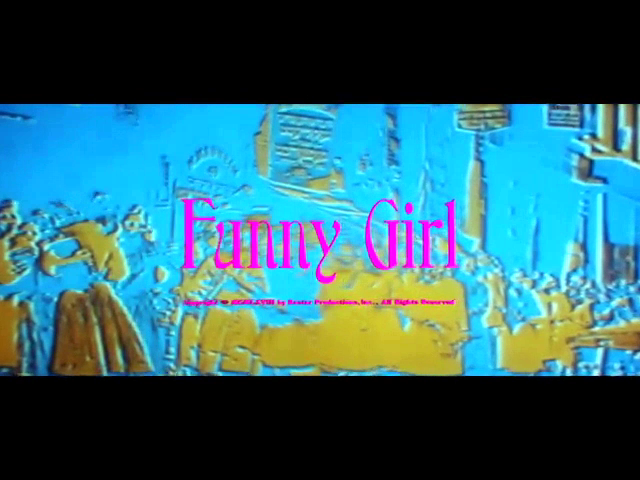 Funny girl (di/by William Wyler, USA 1968) |
A more traditional opening sequence, incorporating the credits, on the background of still images referring forward to the story, is the overture to Funny girl, which, as in most such cases, also provides a summary of the main musical themes which will recur in the film - including the internationally famous song "People", sung by Barbra Streisand (who won the Academy Award for Best Actress). | |
|
Probabilmente non c'è bisogno di presentazioni per la famosissima
sequenza di apertura di 2001:
Odissea nello spazio.
L'ouverture che
apre il film è proprio uno dei tanti temi musicali, tutti presi dalla
musica classica, che il regista Stanley Kubrick ha scelto per
accompagnare alcune delle scene più iconiche del film. Poiché voleva che
il film fosse un'esperienza principalmente non verbale, la musica gioca
un ruolo cruciale, raramente richiesto dalle colonne sonore di film
musicali standard. Se si ascolta con attenzione, gli estratti musicali
appaiono prima o dopo i dialoghi - non c'è praticamente musica di
sottofondo durante i dialoghi. Il tono drammatico di "Also sprach
Zarathustra" di Richard Strauss accompagna la primissima immagine del
sole che sorge sulla luna nello spazio, creando già l'atmosfera per una
storia dal significato universale, persino metafisico. |
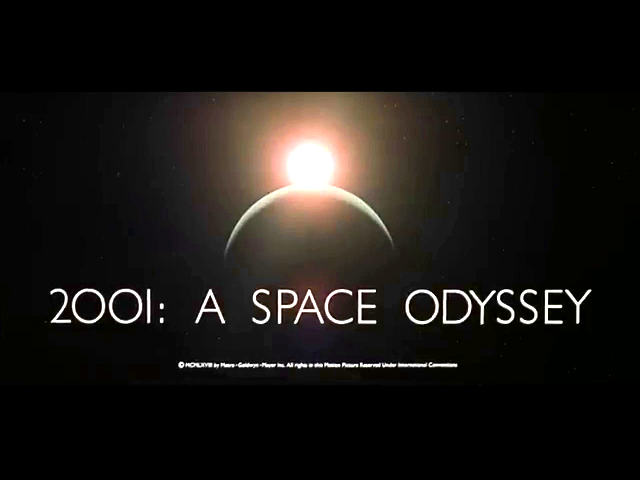 2001: Odissea nello spazio/2001: A space odyssey (di/by Stanley Kubrick, GB/USA 1968) |
No introduction is probably needed for the world-famous opening sequence of 2001: A space odyssey. The overture which opens the film is really one of the several music themes, all taken from classical music, that director Stanley Kubrick chose to accompany some of the most iconic scenes of the film. As he wanted the movie to be a primarily non-verbal experience, music plays a crucial role, one that is seldom required by standard musical film scores. If one listens carefully, musical excerpts appear either before or after dialogues - there is practically no background music during dialogues. The dramatic tone of "Also sprach Zarathustra" by Richard Strauss accompanies the very first image of the sun rising over the moon in outer space, already creating a mood for a story of universal, even metaphysical meaning. | |
|
Potrebbe sembrare un po' strano trovare un'ouverture "classica"
(della durata di circa tre minuti) come sequenza di apertura di Corvo
rosso non avrai il mio scalpo,
western prodotto nel periodo immediatamente successivo alla fine
dell'"Era d'Oro" di Hollywood, e quindi all'inizio di quella che sarebbe
stata chiamata "New Hollywood". Un "western revisionista" diretto da
Sydney Pollack, il film è la storia del leggendario "uomo di montagna"
(un esploratore che vive nella natura selvaggia) Jeremiah Johnson
(interpretato da Robert Redford) e della sua relazione con i nativi
americani. L'ouverture epica,
che sentiamo accompagnata da un'immagine fissa di Johnson che domina il
paesaggio dalla cima di una montagna, stabilisce l'atmosfera per il
film, che si propone di celebrare sia il mito che le difficoltà della
natura selvaggia. |
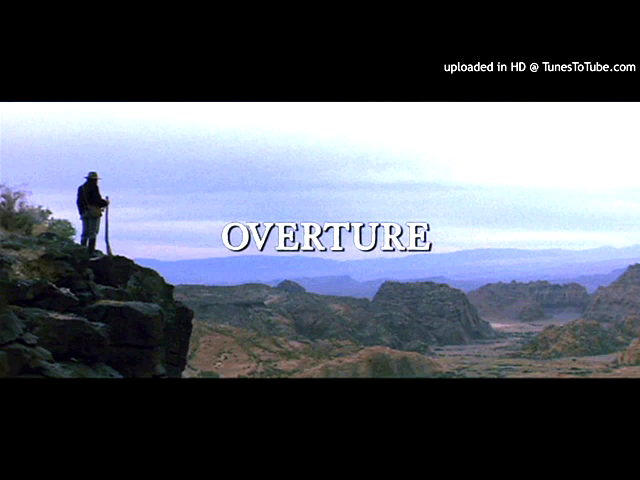 Corvo rosso non avrai il mio scalpo/Jeremiah Johnson (di/by Sydney Pollack, USA 1972) |
It might seem a bit strange to find a "classical" overture (lasting about three minutes) as the opening sequence of Jeremiah Johnson, a western produced in the period immediately following the end of Hollywood's "Golden Era", and therefore at the start of what would be called "New Hollywood". A "revisionist western" directed by Sydney Pollack, the film is the story of the legendary "mountain man" (an explorer who lives in the wilderness) Jeremiah Johnson (played by Robert Redford) and his relationship with the Native Americans. The epic overture, which plays against a fixed image of Johnson dominating the landscape from the top of a mountain, establishes the mood for the film, which sets out to celebrate both the myth and the hardships of the wilderness. | |
|
Un'altra apertura "insolita" segna l'inizio di Indiana
Jones e il tempio maledetto:
anziché mostrare "in azione" l'ormai famoso archeologo / avventuriero,
come era avvenuto con il primo film della saga, questa seconda puntata
inizia con un numero musicale: una cantante di nightclub (Willie Scott)
canta "Anything goes" di Cole Porter in mandarino, seguita da una
coreografia brillante e complessa che è chiaramente un omaggio al
coreografo Busby Berkeley e, più in generale, alla grande tradizione dei
musical hollywoodiani degli anni '30 - e il titolo che compare alla fine
del numero musicale in effetti dice "Shanghai, 1935", riportandoci così
al periodo in cui sono ambientate le storie di Indiana Jones. |
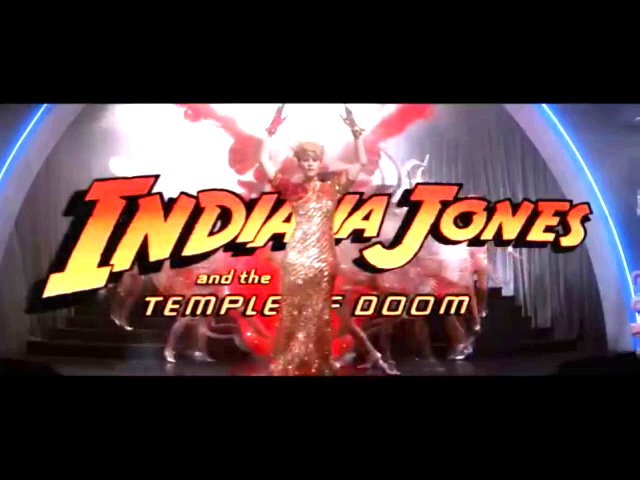 Indiana Jones e il tempio maledetto/Indiana Jones and the Temple of Doom (di/by Steven Spielberg, USA 1984) |
Another "unusual" opening marks the beginning of Indiana Jones and the Temple of Doom: rather than showing the now world-famous archaeologist/adventurer "in action", as had been the case with the first film in the saga, this second instalment starts off with a musical number: a nightclub singer (Willie Scott) sings Cole Porter's "Anything goes" in Mandarin, followed by a a brilliant, complex choreography which is clearly an homage to choreographer Busby Berkeley and, more generally, to the great tradition of Hollywood musicals of the 1930s - and the title which appears at the end of the musical number actually says, "Shanghai, 1935", thus taking us back to the time period in which the Indiana Jones stories are set. | |
| Perché le ouvertures sono praticamente scomparse dalle sequenze di apertura? Le abitudini di visione sono cambiate radicalmente negli ultimi decenni: l'avvento dei video musicali, dei videogiochi e dei video su Internet ha prodotto un pubblico ormai abituato a "entrare nel gioco" fin dall'inizio, a non tollerare quasi nessun ritardo, e desideroso di essere messo al centro dell'azione il più rapidamente possibile. Ciò significa che i film oggigiorno, il più delle volte, iniziano a pieno ritmo, al punto che i titoli di testa sono ridotti al minimo, e persino il titolo del film compare spesso alla fine, insieme ai titoli di coda completi. Ci sono, ovviamente, delle eccezioni, come i film di James Bond, che forniscono ancora elaborate sequenze di apertura, compresi i titoli di testa, che rendono omaggio a una tradizione consolidata, ma si tratta, appunto, di un'eccezione piuttosto che della regola. |
Why have overtures practically disappeared from opening sequences?
Viewing habits have changed dramatically in the past decades: the advent
of music videos, videogames and Internet videos has produced audiences
that are now used to "enter the game" from the very start, hardly
tolerating any delay, and eager to be put in the front seat of the
action as quickly as possible. This means that movies nowadays, more
often than not, start off in full swing, to the point that credits are
reduced to the minimum, and even the title of the film often appears at
the end, together with the full credits. There are, of course,
exceptions, like the James Bond movies, which still provide elaborate
opening sequences, including the credits, paying homage to a
well-established tradition - but those are an exception rather than the
rule. |
||